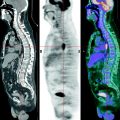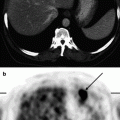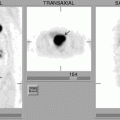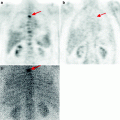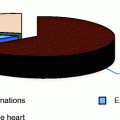, Leonid Tiutin2 and Thomas Schwarz3
(1)
Russian Research Center for Radiology and Surgery, St. Petersburg, Russia
(2)
Department of Radiology and Nuclear Medicine, Russian Research Center for Radiology, St. Petersburg, Russia
(3)
Department of Nuclear Medicine Division of Radiology, Medical University Graz, Graz, Austria
Abstract
It is accepted to distinguish several forms of malignant kidney tumors, the most frequent ones (85%) being hypernephroma or renal cell carcinoma originating from the cells of the renal parenchyma. Kidney sarcoma or Wilms’ tumor is observed exclusively in early childhood and is diagnosed in 90% of cases in children younger than 5 years old. Wilms’ tumor forms almost a half of all malignant tumors in children. Cancer of the renal pelvis originates from the epithelium of the renal pelvis and makes up 7% of all kidney tumors.
It is accepted to distinguish several forms of malignant kidney tumors, the most frequent ones (85%) being hypernephroma or renal cell carcinoma originating from the cells of the renal parenchyma. Kidney sarcoma or Wilms’ tumor is observed exclusively in early childhood and is diagnosed in 90% of cases in children younger than 5 years old. Wilms’ tumor forms almost a half of all malignant tumors in children. Cancer of the renal pelvis originates from the epithelium of the renal pelvis and makes up 7% of all kidney tumors.
Renal cell carcinoma is observed relatively rarely (about 3% of all malignant neoplasms in adults). The frequency of kidney cancer grows by roughly 2.5% annually. The individual risk depends on the age and presence of risk factor for the disease. The exact cause of kidney cancer is unknown; however, due to the results of numerous epidemiological studies some risk factors associated with this disease have been detected.
The incidence of renal cell carcinoma depends on age and achieves its peak by the age of 70 years. Men suffer from the disease twice as often as women do. Smoking is one of the most significant risk factors for development of different malignant neoplasms, including renal cell carcinoma. The risk of kidney tumor in smokers is twice as big as that in non-smokers. In case of abandonment of smoking the probability of developing the disease decreases. Most studies confirm the unfavorable impact of being overweight on the probability of developing kidney cancer. Body weight fluctuations and significant weight gain in adults are independent risk factors for this disease. The exact mechanism of the influence of obesity on the development of kidney tumor is not clear at present. Perhaps it is due to increase in concentration of endogenous estrogens and/or to biological activity of insulin-like growth factors. High risk of developing renal cell carcinoma is reported in persons occupied in the textile, rubber and caoutchouc, and paper industries or dealing with industrial dyes, petroleum and its derivatives, industrial poisons, and salts of heavy metals.
The risk of developing renal cell carcinoma jumps in persons with terminal-stage renal insufficiency in patients on long hemodialysis.
Genetic mutations increase the risk of developing kidney cancer. There is a high probability of kidney cancer in persons with von Hippel–Lindau syndrome. This syndrome is based on the germinal mutation of the VHL gene situated in the chromosome locus 3p25. As a result, abnormal production of many growth factors is observed, in particular of those responsible for angiogenesis. Besides kidney tumors, neoplasms of the pancreas, adrenal glands and brain are observed in mutated VHL gene carriers.
Birt-Hogg-Dube syndrome is characterized not only by the occurrence of chromophobic renal cell carcinomas and oncocytomas but also by the presence of multiple tumors of hair follicles and bronchopulmonary cysts. Mutation of the BHD gene localized in the short arm of chromosome 17 is associated with this syndrome.
In patients with tuberous sclerosis, there are often cysts in the kidneys, liver and pancreas and the probability of developing kidney cancer is higher.
Kidney neoplasms in children represent 20–50% of the total number of tumors observed in childhood. Unfortunately, benign tumors are observed seldomly among kidney tumors in children, malignant kidney tumors in children being in 95%; they are called nephroblastomas or Wilms’ tumors. Wilms’ tumor has been called after the German surgeon Max Wilms (1867–1918), who first described this kidney tumor and established its histogenesis in his monography in 1899. Wilms’ tumor is observed in children of different ages, most frequently from 2 to 5 years old. In 4–5% of cases, a bilateral lesion is observed. Nephroblastoma is very seldomly observed in adults; such patients make up 0.9% of all the kidney tumor patients.
The source of Wilms’ tumor is associated with disturbance in the embryonic development of the fetus; this is attested by its frequent combination with congenital malformations. It has been established that mutations in the WT1 gene not only lead to the development of Wims’ tumor but also manifest themselves by different anomalies of the urogenital organs, aniridia (congenital absence of the iris), congenital hemihypertrophy, Beckwith–Wiedemann syndrome. Besides detected disturbances in certain genes, an important role in developing nephroblastoma has been recently assigned to dysregulation of fetal mitogens, in particular to the elevated expression of the gene of insulin-like growth factor 2.
Cancer of the renal pelvis is a malignant kidney tumor originating from the transitional epithelium of the pelvis and accounting for about 7% of all kidney tumors. Depending on the histological structure, three forms of malignant epithelial neoplasms are distinguished: transitional cell carcinoma, planocellular cancer and adenocarcinoma. Most neoplasms of the renal pelvis and ureter are represented by transitional cell carcinoma. This kind of tumor is often observed in patients with chronic pyelonephritis and sometimes accompanies leukoplakia of the pelvis. From the diagnostic and therapeutic points of view, a very important characteristic of papillary cancer of the pelvis is the fact that in 50% of patients with this disease a similar blastomatous process in the ureter or in the urinary bladder or in both is simultaneously observed. Consequently, simultaneous lesion of the renal pelvis, ureter and urinary bladder with papillary tumors is a typical phenomenon. Therefore, in case of suspicion of this kind of neoplasm it is necessary to examine the whole urinary tract.
The risk of developing cancer of the renal pelvis is several times higher in smokers compared with non-smokers. When smoking, concentration of intermediates of tryptophan metabolism increases, these intermediates having a structure similar to that of orthoaminophenol and are strong carcinogens.
It has been established that long presence of concrements in the renal pelvis increases risk of planocellular cancer of the renal pelvis; these concrements are carcinogens and induce hyperplasia of the urothelium.
The WHO classification is now the most complete and perfect; it has been drawn up by a working group of leading pathologists from different countries and adopted as a result of a consensus achieved in discussing the problem at the Lyon conference in 2002. The WHO classification groups tumors according to tissues to which they belong and to degrees of their malignancy.
In the present chapter devoted to kidney cancer, we thought it suitable to include only a fragment of the WHO histological classification concerning malignant kidney tumors.
11.1 WHO Histological Classification of Malignant Kidney Tumors
Renal Cell Tumors
Nephroblastic Tumors
Mesenchymal Tumors
Neuroendocrine Tumors
Tumors of the Hemopoietic and Lymphoid Tissues
Germinogenic Tumors
Choriocarcinoma
Metastatic Tumors
The most frequent is clear cell kidney cancer (60–85%), while the rarest histological type of renal cell cancer is collecting duct tumor (1–2%).
It should be noted that the presented classification embraces only neoplasms of the renal parenchyma and does not include the pelvicalyceal system. The practical suitability of dividing malignant kidney tumors into those of the renal parenchyma and those of the renal pelvis does not provoke doubts since they differ from each other in histological structure, ways of metastasizing and methods of treatment.
The morphological characteristic of the tumor process includes also gradation of degrees of malignancy:
Gx – the degree of malignancy cannot be assessed
G1 – high-differentiated tumor
Stay updated, free articles. Join our Telegram channel

Full access? Get Clinical Tree


